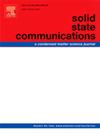Preparation and thermophysical investigations of water and ethylene glycol based CuO nanofluid using cationic CTAB surfactant for heat transfer application
IF 2.4
4区 物理与天体物理
Q3 PHYSICS, CONDENSED MATTER
引用次数: 0
Abstract
In this study, we report the synthesis of copper oxide (CuO) nanoparticles and water, ethylene glycol based nanofluid for heat transfer application. The sol-gel self-ignition technique was chosen for its ability to produce high-purity, homogeneous materials. The prepared CuO precursor underwent calcination at 550 °C to enhance crystallinity and remove organic components. A comprehensive characterization of the synthesized CuO nanoparticles were performed using multiple analytical techniques. XRD analysis shows the CuO nanoparticles with crystalline nature and revealed an average crystallite size of 19 nm, calculated using the Debye-Scherrer equation. UV–Visible spectroscopy technique was utilized to analyse the optical properties, revealed the band gap of 2.20 eV, which confirms the semiconducting nature of CuO. The FTIR spectrum of CuO shows characteristic peaks at 470 cm−1 and 414 cm−1 confirms the of CuO nanoparticle formation. Field Emission Scanning Electron Microscopy (FESEM) was utilized to analyse the morphology and size distribution of the nanoparticles. SEM imaging revealed grain size of 41.9 nm. To explore the potential of the synthesized CuO in thermal management applications, a nanofluid was formed by dispersing the prepared nanoparticles with CTAB surfactant of different volume fraction in deionized water and ethylene glycol. The stability of the prepared nanofluid was tested through zeta potential studies. The thermal conductivity increases with CuO volume fraction for both water and ethylene base nanofluids. CuO nanoparticles demonstrate the potential of this material for heat transfer applications, opening avenues for improved thermal management in industrial and technological applications.
基于阳离子CTAB表面活性剂的水基和乙二醇基CuO纳米流体的制备及热物理研究
在这项研究中,我们报道了氧化铜纳米颗粒和水、乙二醇基纳米流体的合成,用于传热应用。选择溶胶-凝胶自燃技术是因为它能够产生高纯度、均匀的材料。制备的CuO前驱体在550℃下煅烧,以提高结晶度,去除有机成分。采用多种分析技术对合成的纳米CuO进行了全面表征。XRD分析表明,CuO纳米颗粒具有结晶性质,平均晶粒尺寸为19 nm,采用Debye-Scherrer方程计算。利用紫外可见光谱技术分析了CuO的光学性质,发现其带隙为2.20 eV,证实了CuO的半导体性质。在470cm−1和414cm−1处发现了CuO的特征峰,证实了CuO纳米颗粒的形成。利用场发射扫描电镜(FESEM)分析了纳米颗粒的形貌和尺寸分布。SEM成像显示晶粒尺寸为41.9 nm。为了探索合成的CuO在热管理中的应用潜力,将制备的纳米颗粒与不同体积分数的CTAB表面活性剂分散在去离子水和乙二醇中形成纳米流体。通过zeta电位研究对制备的纳米流体的稳定性进行了测试。水基和乙烯基纳米流体的导热系数随CuO体积分数的增加而增加。CuO纳米颗粒展示了这种材料在传热应用方面的潜力,为工业和技术应用中改善热管理开辟了道路。
本文章由计算机程序翻译,如有差异,请以英文原文为准。
求助全文
约1分钟内获得全文
求助全文
来源期刊

Solid State Communications
物理-物理:凝聚态物理
CiteScore
3.40
自引率
4.80%
发文量
287
审稿时长
51 days
期刊介绍:
Solid State Communications is an international medium for the publication of short communications and original research articles on significant developments in condensed matter science, giving scientists immediate access to important, recently completed work. The journal publishes original experimental and theoretical research on the physical and chemical properties of solids and other condensed systems and also on their preparation. The submission of manuscripts reporting research on the basic physics of materials science and devices, as well as of state-of-the-art microstructures and nanostructures, is encouraged.
A coherent quantitative treatment emphasizing new physics is expected rather than a simple accumulation of experimental data. Consistent with these aims, the short communications should be kept concise and short, usually not longer than six printed pages. The number of figures and tables should also be kept to a minimum. Solid State Communications now also welcomes original research articles without length restrictions.
The Fast-Track section of Solid State Communications is the venue for very rapid publication of short communications on significant developments in condensed matter science. The goal is to offer the broad condensed matter community quick and immediate access to publish recently completed papers in research areas that are rapidly evolving and in which there are developments with great potential impact.
 求助内容:
求助内容: 应助结果提醒方式:
应助结果提醒方式:


